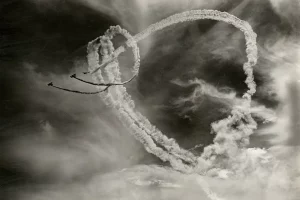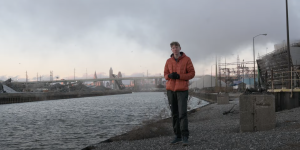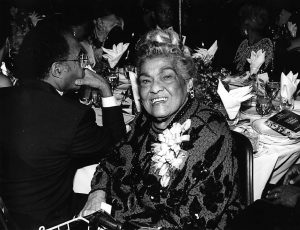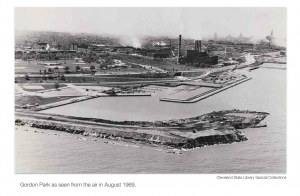
Will Cleveland Ever Develop Its Lakefront?
New Plans Are a Step Closer The pieces coming together for a bold, new vision for the lakefront.
by Ken Prendergast – Cleveland Magazine August 2022
The link is here
www.teachingcleveland.org

Will Cleveland Ever Develop Its Lakefront?
New Plans Are a Step Closer The pieces coming together for a bold, new vision for the lakefront.
by Ken Prendergast – Cleveland Magazine August 2022
The link is here


CLEVELAND, Ohio — They were big, bold, and visionary. And they never made it from blueprint to reality.
Since the late 1980s, planners, developers, and civic organizations have come up with at least nine big plans for developing the downtown lakefront, including proposals about how to better connect downtown to Lake Erie. Yet downtown is still firmly separated from the water by the Ohio 2 Shoreway and rail lines used by Norfolk-Southern and the Greater Cleveland Regional Transit Authority.
Here’s a list of the lakefront proposals, and what happened to them:
– The city’s 1988 Civic Vision 2000 Downtown Plan included Progressive Corp.’s proposal to build a lakefront skyscraper headquarters designed by architect Frank Gehry that would have risen next to an extension of the downtown Mall overlooking North Coast Harbor. Progressive dropped the idea and built its headquarters in suburban Mayfield.
(Related coverage: Could downtown Cleveland’s parks and public spaces be more fun and better programmed? A new survey seeks answers)

– A new downtown plan called “Civic Vision 2000 and Beyond’’ grew out of a closed-door process in 1997-98 led by executives of Cleveland Tomorrow, representing the city’s top corporate leaders. The plan included a concept for linking downtown more strongly to the lakefront. After a big rollout, it never gained momentum.

– In 2001, Cleveland Tomorrow and the Growth Association, then the city’s chamber of commerce, followed up with a concept called “The Shoreway: Reclaiming Our Lakefront’’ that aimed at revamping the lakefront highway to foster development between downtown and the lakefront. The proposal was the first to take a serious look at the issue.
– In 2004, the city completed its Waterfront District Plan, the biggest lakefront vision in 50 years. It was led by then-city planning director Chris Ronayne, working under former mayor Jane Campbell. (Ronayne is now the Democratic candidate for Cuyahoga County executive.) The plan called for extending the Mall over the Shoreway in a manner that anticipated a proposal like the 2021 Haslam proposal.

– A 2009 plan developed under then-mayor Frank Jackson, led by waterfront planner Stanton Eckstut, called for extensive redevelopment of lakefront land owned by the city and the Port of Cleveland, with new blocks oriented diagonally to deflect prevailing winds. A 2012 update included a spot for a pedestrian bridge from the Mall to North Coast Harbor.

– The 2010 Cleveland Design Competition, conceived by local architects, challenged contestants to figure out how to use a multi-modal transportation hub as a connector between downtown and the lakefront. Entries by more than two-dozen teams came from around the world. The ideas were visionary but failed to motivate action.

– In 2013, expanding on ideas from the Eckstut proposal in 2009, Cleveland developer Dick Pace and Texas-based developer Trammell Crow proposed widening the East Ninth Street bridge over the Shoreway with a parklike expansion and building a Mall extension slightly to the east of the one later proposed by the Haslams. The city didn’t approve of the idea, Pace said.

– In 2014-2016, the non-profit Group Plan Commission proposed an eye-catching, $25 million pedestrian bridge designed by Boston architect Miguel Rosales, to connect the Mall to the Rock Hall. After the estimated construction cost rose, the city rejected the concept as impractical and too expensive.

– A 2019 concept developed by the nonprofit Green Ribbon Coalition proposed extending the Mall as a wide “land bridge’’ oriented northeast toward North Coast Harbor. The concept stirred public interest, but the city stayed mum on it until Jackson said in 2021 that he liked the Haslam proposal, which he described as a “land bridge.”




by Jacob T Mach, 2020, Master of Arts (MA), Bowling Green State University, History.
Ohio politics during the Reconstruction era has received sparse treatment by historians. Not until 1970 with Felice Bonadio’s North of Reconstruction was there a monograph solely dedicated to Ohio politics during the era. Robert Sawrey wrote his Dubious Victory in 1992, but still the historiography on Reconstruction Ohio remains dramatically underdeveloped. In Ohio, the question of African American suffrage was the single most divisive issue facing politicians during the era. Radical Republicans brought a referendum before the people of Ohio in 1867 to change the state constitution to protect the suffrage rights of both white and black males above the age of 21. The measure failed 216,987 votes (45.9 percent) to 255,340 (54.1 percent) votes. The failure of the suffrage amendment disheartened many Radical Republicans across Ohio and the rest of the North, yet Ohio Republicans managed to elicit more support for suffrage than most states in the North. Such support did not arise randomly; it intentionally developed over a three-year period beginning after the Civil War. Two primary research questions drive this project: 1) Did suffrage become a crucial issue in the state of Ohio earlier than the existing historiography suggests, 2) why were Ohio radicals able to generate more support for black suffrage within the Republican party than in other states in the North? By showing that Republican support (through Congressional voting records, public support via speeches and letters, and by Republican-sympathetic papers throughout the state) for black suffrage existed in significant numbers in 1865 (prior to 1866-1867, as Bonadio, Sawrey and others suggest) in both the Western Reserve and in other parts of the state and only continued to grow until the referendum in the fall of 1867, this project will argue that black suffrage was not only being pursued by radicals, but ultimately by the vast majority of the Republican party. Ohio’s inability to secure black suffrage with overwhelming Republican support will in turn help to explain why other northern states achieved even less success in their pursuit of black suffrage.
 In a State of Access: Ohio Higher Education, 1945 – 1990
In a State of Access: Ohio Higher Education, 1945 – 1990
by Jonathan Tyler Baker, 2020, Doctor of Education, Miami University, Educational Leadership.
The link is here
In a State of Access is a historical study about the way public higher education in Ohio became both generally accessible to nearly every citizen while also offering elite undergraduate and graduate programs. This project grapples with the question of how national, state and regional factors – from the mid-1940s through the end of the 20th century – influenced the way Ohio’s leaders viewed the purpose of public higher education and influenced whether Ohio’s leaders chose to focus on making public higher education more selective or accessible. State leaders initially balked at the idea of funding public higher education. When they did decide to make the investment, ideological battles, economic stagnation and the state’s budget deficit continually influenced how state leaders viewed the purpose of public higher education. As a result, state leaders never succeeded in building a system of public higher education that reflected a clearly defined, well-organized purpose. This dissertation is the first full-length study about contemporary public higher education in Ohio and one of the few case studies of any state’s system of higher education. As the public and politicians at the state and national level pay more attention to the accessibility of higher education, and the role of a college degree in a globalized, service economy, a case study of Ohio helps us to better understand why public higher education is still struggling with problems over access.
 The Shame of the Buckeye State: Journalistic Complacency on Episodic Lynching in Ohio from 1872 to 1932
The Shame of the Buckeye State: Journalistic Complacency on Episodic Lynching in Ohio from 1872 to 1932
by Rounkles M Claire, 2020, Master of Science (MS), Ohio University,
Journalism (Communication)
The link is here
The lynching era in Ohio lasted from 1803 to 1937. During these years thirty-five people died at the hands of a lynch mob and seventy-nine escaped from a mob’s clutches. This thesis situates the history of lynching in Ohio from 1872 to 1932 and discusses the issue of complacent journalism in the Ohio press through a study of twenty-four cases of white-on-white lynching and racial terror lynching. This thesis shows that lynching was employed as a means to enact fear to keep Black Ohioans in a marginalized position and prevent them from prospering economically or politically. The author also argues that journalists were not objective bystanders but were key to the social voice and national conversation that accepted the practice of lynching in America. By utilizing the concept of critical race theory, the author shows that the racist ideal of Whiteness was able to become hidden by seemingly objective reporting, thus allowing the mainstream press to accept the practice of lynching without the guilt of unlawful “justice.” There is also a paucity of research on Harry C. Smith, a Black journalist who pushed for the first anti-lynching law in Ohio. As such, this research aims to make a significant impact not only on the literature involving northern lynchings but also in the history of Ohio and the need to understand its dark past. In 2020 this historical research hold saliency regarding the racial violence which continues today in America.
 Rockefeller Park: The crown jewel of University Circle; the vision of 19th Century benefactors
Rockefeller Park: The crown jewel of University Circle; the vision of 19th Century benefactors